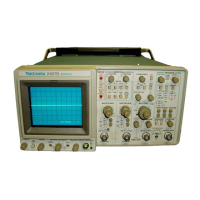Theory of Operation—2465B/2467B Service
changed to a current through R4453 to the emitter of
Q4454.
Common base amplifier Q4454 is used as a
current to high voltage converter with a large output swing
of 85 volts (+75 volts to minus 10 volts). The output is
bypassed before going through current limiting resistor
R4452 to the Astigmatism
grid,
pin 8.
EDGE FOCUS. Edge Focus potentiometer R4342
adjusts the voltage to optimize the edge focus of the
displayed waveform. The potentiometer can swing the
voltage on CRT pin 12 above and below the +42 volt level
on Anode 1.
MCP-CRT Control Circuits
The CRT Control circuits provide the signal attenuation
factors and various level setting potentials to drive the ele-
ments of the CRT. The signal portion terminates the Verti-
cal deflection plate delay elements and is called Vertical
Termination. The three level setting circuits produce
currents and voltage levels necessary for the CRT to
operate properly. The Trace Rotation, Geometry, and Y-
Axis Alignment complete the necessary adjustments for
proper crt operation.
VERTICAL TERMINATION. CRT termination
adjustment R1301 is set to match the vertical deflection
plates to Vertical Output Amplifier U600 (diagram <6>,
2467B).
TRACE ROTATION. TRACE ROTATION potentiometer
R975 is a front-panel screwdriver-adjustable control. It
controls the amount of positive or negative current through
trace rotation coil L90. The adjustment magnetically
rotates both the x-axis and y-axis deflections of the CRT
trace so that the trace can be aligned to the internal
graticule markings.
GEOMETRY. Geometry potentiometer R4350 controls
the voltage that optimizes the geometry of the displayed
waveform. It can adjust the voltage on CRT pin 10 above
and below the +42 volt level on Anode 1.
Y AXIS ALIGNMENT. Y-AXIS (vertical) ALIGNMENT
potentiometer R4370 rotates the the beam after vertical
deflection but before horizontal deflection. This adjustment
controls the amount of positive or negative current through
the Y-Axis Alignment
coil.
The coil is located between the
vertical and horizontal deflection plates and is wound on
the neck of the crt. Current through the coil magnetically
rotates the vertical portion of the trace. The control is
adjusted to produce precise perpendicular alignment
between the x-axis and y-axis deflections.
LOW VOLTAGE POWER SUPPLY
The low voltages required by the instrument are pro-
duced by a high-efficiency, switching power supply. This
type of supply directly rectifies and stores charge from the
ac line supply; then the stored charge is switched through
a special transformer at a high rate, generating the various
supply voltages.
Line Rectifier
Ac line voltages of either 115 V or 230 V may provide
the primary power for the instrument, depending on the
setting of LINE VOLTAGE SELECTOR switch S90
(located on the instrument rear panel). Power Switch S350
applies the selected line voltage to power supply rectifier
CR1011.
With the selector switch in the 115 V position, the
rectifier and storage capacitors C1021 and C1022 operate
as a full-wave voltage doubler. When operating in this
configuration, each capacitor is charged on opposite half
cycles of the ac input, and the voltages across the two
capacitors in series will approximate the peak-to-peak
value of the source voltage. For 230 V operation, switch
S90 connects the rectifier as a conventional bridge
rectifier. Both capacitors charge on both input half cycles,
and the voltage across C1021 and C1022 in series will
approximate the peak value of the rectified source voltage.
For either configuration, the dc voltage supplied to the
power supply inverter is the same.
Thermistors RT1010 and RT1016 limit the surge
current when the power supply is first turned on. As
current flow warms the thermistors, their resistances
decrease and have little effect on circuit operation.
Spark-gap electrodes E1001 and E1002 are surge-voltage
protectors. If excessive source voltage is applied to the
instrument, the spark-gaps conduct, and the extra current
flow quickly exceeds the rating of fuse F90. The fuse then
opens to protect the instrument's power supply. The EMI
(electromagnetic interference) filter, inductors L1011 and
L1012,
capacitors C1016 and C1018, and resistors
R1011,
R1012,
R1016 and R1018 form a line-filter circuit. This
filter, along with common mode rejection transformer
T1020,
prevents power-line interference from entering the
instrument and prevents power supply switching signals
from entering the supply line.
Preregulator Control
The Preregulator Control circuit monitors the drive volt-
age applied to inverter output transformer T1060 and
holds it at the level that produces proper supply voltages
at the secondary windings.
3a-46

